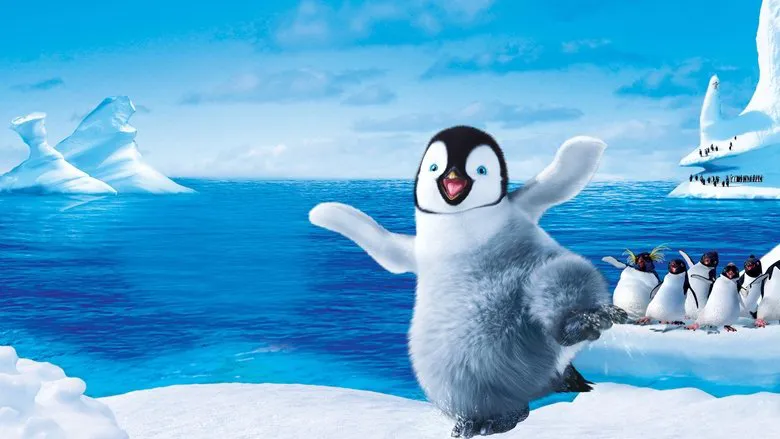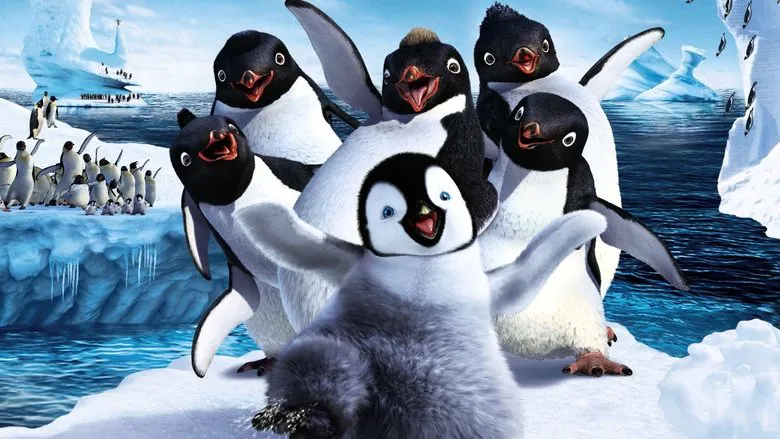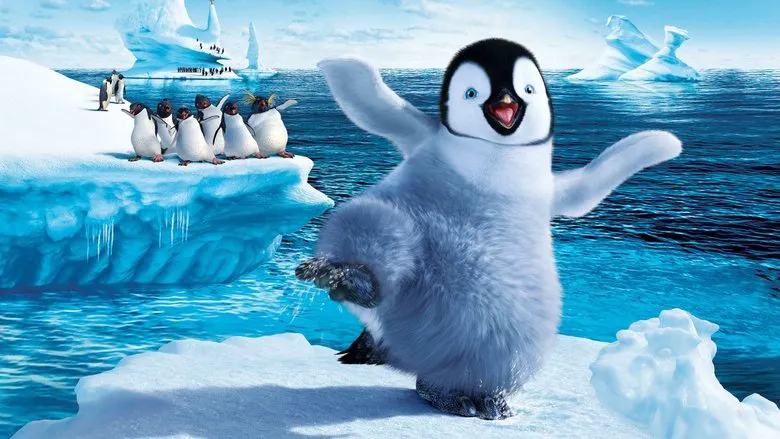“Happy Feet”: A Penguin Musical Raids Baby’s Piggy Bank
Upon its release, “Happy Feet” marked a definitive shift in cinema’s target audience: independent individuals aged twelve to nineteen, equipped with wallets plump enough to cover not only the ever-increasing ticket prices but also a soda. While parents might find moments of amusement in this full-length animated feature, and film aficionados will appreciate the unprecedented fluidity of the camera work in animation, the overall experience may prove underwhelming.
Step by Step Around

The film offers glimpses of entertainment for parents, such as a charming penguin striking an Elvis Presley pose or belting out “My Way.” Film enthusiasts will admire the dynamic camera work, a rarity in animation. However, the film may lack sustained engagement for a broader audience.
Interestingly, the film’s closest relative in documentary form is “March of the Penguins” (2004), which first depicted the intricate life of a penguin community, the paternal duty of incubating eggs, and the perilous journeys of mothers to gather food for their offspring. “Happy Feet” borrows heavily from “March,” incorporating these elements into its animated narrative. However, the film’s execution is uneven. Initially, the story of a penguin who taps rather than sings is reminiscent of “The Ugly Duckling” and quite endearing. However, the filmmakers seem unsure of what to do with the penguins for the remaining time, sending the protagonist on a quest to persuade human “aliens” to stop overfishing and depriving the birds of their food source. The film veers into environmental advocacy, but the transition feels forced, especially compared to the “documentary” beginning.
The term “documentary” is not used casually here. This is a relatively new type of animation: photorealistic. An early example is “Final Fantasy: The Spirits Within” (2001), where parameters from sensors attached to actors were fed into a computer. “The Polar Express” (2004) followed a similar principle, with all roles played by Tom Hanks, whose likeness was unmistakably captured in the computer-generated images. The penguins in “Happy Feet” are naturalistic down to the last feather, only they speak with the voices of Elijah Wood and Robin Williams (a nuance inevitably lost in dubbing).
This is the most complex 3D animated film ever produced. Its end credits are the longest, listing over a thousand names. While the artistic result may not rival Disney’s hand-drawn “Snow White and the Seven Dwarfs” (1937), the box office returns are incomparable. “Happy Feet” was released on November 19 on 3,804 screens in the US and grossed $41.5 million in its opening weekend, surpassing the latest James Bond installment, “Casino Royale” (2006) ($40.8 million)! In contrast, Tim Burton’s “Corpse Bride” (2005) was released on just 5 screens and earned $385,000 in its opening weekend. By the end of 2005, it had grossed $53 million, barely recouping its $40 million budget. It proved too artistic for the new audience.

The Boomerang Effect
This reflects a noticeable decline in audience sophistication. The business plans of commercial cinema are backfiring, delivering a fatal blow: the audience is rapidly changing and will soon be unable to appreciate even “Titanic” as a complex and artistically inaccessible work. Meanwhile, the proportion of films aimed at non-thinking teenagers is steadily increasing. The top ten lists for cinema screenings and video sales now invariably include two or three animated novelties like “Cars” (2006), “Madagascar” (2005), “Monster House” (2006), or “Ice Age” (2002). These films consistently lead the charts.
However, a vicious cycle has emerged. The cost of film production is rising: today, a film budget that doesn’t approach $100 million is not considered serious. Consequently, ticket prices are soaring. In these circumstances, the continuous lowering of the age threshold for cinema audiences is inevitable. While adults can easily forgo the habit of going to the movies (they have many other ways to enjoy themselves, including sitting with a glass of whiskey in front of a home video screen), for teenagers, socializing is the primary form of communication. Movie theaters in the human zoo have become like “youth hangouts,” and even here, the age limit tends to decrease, as evidenced by the failure of “Corpse Bride,” which would have been a box office hit in the 1990s. Clearly, this process must have a limit – films can’t be shown to infants. But there is still room for maneuver, and cinema is rapidly falling into childhood.
The film business understands that parents, even if they have to economize on themselves, are unlikely to deny their offspring pocket money. And it makes adjustments to its repertoire plans. Ten years ago, full-length animation was a rare commodity: expensive to produce, requiring enormous labor costs, it was not considered profitable. The incredible success of computer blockbusters “Antz” (1998) and “Shrek” (2001) not only put their production on stream, but also forced the American Film Academy to introduce a special “Oscar” nomination for them.
The pace of development of computer animation is staggering. Its pioneer can be considered “Toy Story” (1995). With an expenditure of $30 million, it earned almost $192 million in its first year, opening the way to gold mines. It took another three years to establish mass production. In 1998, two films about insects were released – “Antz” and “A Bug’s Life” (1998), in 2001, four at once, including “Shrek,” and already in 2006, a cartoon was released every month, between which a competitive squabble began. In 2007, 14 films are promised in the US alone, including “Shrek the Third” (2007). Japan is rapidly capturing the world market with its mystical “anime.” The powerful industry of Indian Bollywood has awakened. The French have stirred, making “The Triplets of Belleville” (2003).

Drifting Freely
Starting with Disney’s “Snow White” and “The Jungle Book” (1994), full-length cartoons were considered family viewing. Today, the tradition is rapidly disappearing: films are being churned out so hastily that a piece product has become a mass stamping, a rattle for toddlers. Cinema is increasingly choosing not the father and mother with their son and daughter as its “target” audience, but the son and daughter: they will independently drool under the roar of colored pictures, fearlessly spending money on new and new viewings.
But if family viewing is always the help of parents in comprehending the complex, then yesterday’s infant can be let into independent swimming if there is not a sea of life in front of him, but a heated compote. Cinema has begun to appeal to simple instincts and no longer requires thinking. And this is a completely new type of relationship between the film and the public: the film is laid out for it, asks: does it not bother? It caters to all instincts, including potentially dangerous ones. Its new audience is physically maturing, but in its relationship with cinema it remains at the level of “Cars.” It is more infantile, and sociological surveys show that this audience treats cinema as an amusement park (the same “roller coasters,” “caves of horrors,” and popcorn kiosks) or as a video game, to which computer animation is a close relative.
With the development of the home cinema industry, which is becoming more and more perfect in terms of image and sound quality, communication with the film is moving from the cinema to our living room or bedroom. In this competitive battle, the cinema remains to put forward as decisive trump cards the effect of “collective viewing,” where viewers emotionally infect each other, and the magic of the “big screen,” which surpasses even plasma in spectacle. This means that the stakes of chases, explosions, mindless, but adrenaline-pumping viewing are increasing.
Our Turn to Catch Up
Russian animation had developed traditions. All this has been lost and plundered, and only Oleg Vidov, having bought the masterpieces when they were lying badly, digitizes them and releases them in world distribution in excellent quality - otherwise they would have perished altogether. And the industry arises from zero. In search of “its territory,” our animation turned to the plots of Russian epics, but already in “Alyosha Popovich and Tugarin the Serpent” (2004) it frankly stole Shrek’s talkative Donkey, turning him into a talkative horse. “Prince Vladimir” (2006) is more successful: it uses manual technology, the musical aura is well conceived, there is a little Disney magic, a lot of patriotism, but no humor at all. The film did not go beyond the country, but in Russia it appeared on 292 copies and grossed $1.8 million over the weekend, which is not very encouraging with a 5-million budget.
Let’s clarify: the era of “cinema for all time,” which worked for decades, has apparently passed. Today is the era of “one-day cinema,” designed for an assault with a powerful advertising campaign. Today’s “events” are forgotten tomorrow. Who will now return to the “main film of the year” “The Lord of the Rings”, who will want to review the first part of “Harry Potter”? Hence the thousands of copies in the USA, hence the assertive advertising, making a conjuncture one-day event “the event of the century.”

Our cinema is also trying to reach this finish (for cinema as an art) straight line and is proud of the fact that the teenage “fantasy” “Night Watch” (2004), as they write, is triumphantly going around the world. It goes, but let’s not be deluded: the film premiered in the USA in February 2006 on three screens and grossed $106.5 thousand in its opening weekend. When the number of screens was increased to nine at the end of April, only 4 thousand dollars were in their box offices for three days of the weekend - a failure by American standards.
The locomotive of cinema is not the talent of the author and not even a socially demanded topic, but an advertising clip - the more persistently it is played on the radio and TV, the louder the event, the more definitely the need to not stay away from the new sensation is formed in the public (“The Island” (2006) by Pavel Lungin - a vivid example).
Our distributors have become psychologists. Realizing that they live in a country where criminal consciousness triumphs, they rework “non-cash” foreign names into the native jargon of the “brothers”: “Shark Tale” became “Shark Tale” (2004), “Over the Hedge” - “Forest Brotherhood” (2006), “Cars” - “Cars” (2006), now “Happy Feet” has turned into “Happy Feet”, which in the language of “raspberry” means “Run before you sweep.” This has nothing to do with a film about a dancing penguin, but it doesn’t matter: it’s important that you and I peck and get caught on the hook.
The recently released “Wolfhound” (2006) - another domestic blockbuster of the century - confirms the relevance of our conversation. It has chic special effects, there are no developed characters, the actors have nothing to play, and the director not only does not try, but may not be able to build from the thundering pictures neither a story that can hold attention for a long two and a half hours, nor a holistic world in which it flows. A computer game has been released, where it does not matter who is who and what is happening here, but it is important how the rocks collapse, and how amazingly the bridge across the abyss is similar to its counterpart from “King Kong” (2005) - we can, when we want to! And thinking is contraindicated, and if you give the “Golden Eagle” - then only to a bat, which always woke up the dozing hall in time.
It’s time to replace the chairs in the cinema with cradles - and the success will be overwhelming.